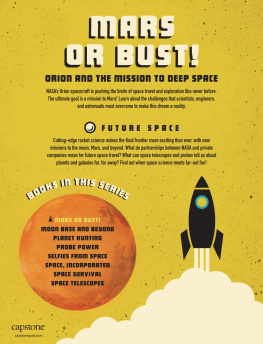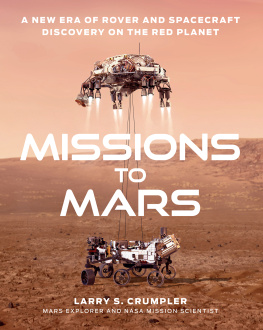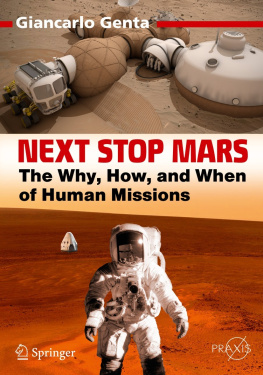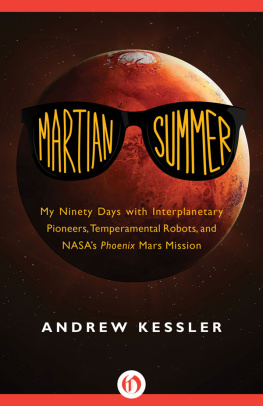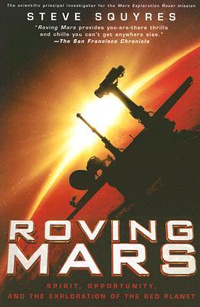ACKNOWLEDGMENTS
A multitude of people, institutions and technologies energized the construction of this book. Given the nature of ethnographic research methods, not all can be acknowledged explicitly by name. They are appreciated privately. Thank you to all of the members of NASAs MER mission 20032004.
This work has benefited from questions, comments, silences and challenges from many audiences and individuals. Many thanks to the institutions and individuals that provided forms of access and inspiration, including: the University of California San Diego (UCSD), Leigh Star, Valerie Hartouni, Yrj Engestrm, Edwin Hutchins, Chandra Mukerji, Robert Horwitz, Sharon Traweek (UCLA), Carol Padden, Michael Cole, Katie Vann; the UCSD Science Studies Program, Geoffrey Bowker, Andrew Lakoff, Steven Shapin, Naomi Oreskes, Steve Epstein, Martha Lampland, Miriam Padolsky, Katrina Hoch, Kathleen Casey, Matthew Shindell, Sophia Efstathiou; the Massachusetts Institute of Technology, Science Technology and Society Program, Teasel Muir-Harmony, Lisa Messeri, David Mindell, Leo Marx, Yanni Loukissas, Tim Cullen, Lisa DAmbrosio; Harvard University, Program on Science, Technology and Society, Sheila Jasanoff; NASA Ames, John ONeill, Mike Shafto, Roxana Wales, Valerie Shalin, William Clancey, Charlotte Linde, Chin Seah, Jay Trimble, Kanna Rajan; the Jet Propulsion Laboratory, Deborah Bass, John Callas, the Athena science team, Steve Squyres, Andy Mishkin; and, the MIT Press, Katie Helke, Wiebe Bijker, Bernard Carlson, Trevor Pinch, Judith Feldmann, and this books production team and reviewers. I would like to thank and acknowledge conference and workshop audiences, and individuals, including the Society of the Social Study of Science, the National Communication Association (NCA), the NCA Association for Rhetoric in Science and Technology, the Standing Conference on Organizational Symbolism, the International Society for the Study of Time, the American Anthropological Association, the MIT Museum, Willow Garage, and Monterey Bay Aquarium Research Institute; Olga Hasty, Dawna Ballard, Ida Sabelis, Frederick Turner, Leila Takayama, Shana Ashar, Carol Pfeifer, Naj Abroni, Talat Bahrami, Carol Robideau, Ameh Zari, Mina and M. R. Mirmalek, Ida Stiffarm, Veda Mirmalek, Aaron Mirmalek, Leonard Peltier, RJ, DH, MK, FD, JC, Matt Chavez, Veronica Marquez, and Timothy Denehy.
One final group I must acknowledge is the technology on which I relied during MER: spiral-bound three-subject notebooks modified with foam board backing, 1.7mm ballpoint pens, highlighters, two laptops, software, printer, two cameras, and sticky notes.
BIBLIOGRAPHY
- Abbe, Truman. Professor Abbe and the Isobars. New York: Vantage Press, 1955.
- Ackmann, Martha. The Mercury 13: The True Story of Thirteen Women and the Dream of Space Flight. New York: Random House Trade Paperbacks, 2003.
- Adams, Cyrus C. The North Pole at Last. Edited by Albert Shaw. American Review of Reviews 40 (1909): 420433.
- Adams, Guy B., and Danny L. Balfour. Unmasking Administrative Evil. Advances in Public Administration. Thousand Oaks: Sage, 1998.
- Adams, Walter S. The Founding of Mount Wilson Observatory. Astronomical Society of the Pacific 66, no. 393 (1954): 267303.
- Alac, Morana. Handling Digital Brains. Cambridge, MA: MIT Press, 2011.
- Allison, Michael. Accurate Analytic Representations of Solar Time and Season on Mars with Applications to the Pathfinder/Surveyor Missions. Geophysical Research Letters 24 (1997): 19671970.
- Allison, Michael, and Megan McEwen. A Post-Pathfinder Evaluation of the Areocentric Solar Coordinates with Improved Timing Recipes for Mars Season/Diurnal Climate Studies. Planetary and Space Science 48 (2000): 215235.
- Alvesson, Mats, and Hugh Willmott. Studying Management Critically. Thousand Oaks, CA: Sage, 2003.
- Anderson, F. Scott, Albert F. C. Haldemann, Nathan T. Bridges, Matthew P. Golombek, Timothy J. Parker, and Gregory Neumann. Analysis of MOLA Data for the Mars Exploration Rover Landing Sites. Journal of Geophysical Research: Planets 108, no. E12 (2003): 8084. doi:10.1029/2003JE002125.
- Anderson, Robert C., A. F. C. Haldemann, James Dohm, and Terry Huntsberger. A Dress Rehearsal for the 2003 Mars Exploration Rovers. In Mars Analog Research, vol. 111, edited by Johnathon D. A. Clarke, 117128. San Diego, CA: American Astronautical Society, 2006.
- Anderson, Nels. Dimensions of Work. New York: D. McKay, 1964.
- Ansari, Anousheh, and Homer Hickam. My Dream of Stars: From Daughter of Iran to Space Pioneer. New York: St. Martins Griffin, 2010.
- Baba, Marietta. The Globally Distributed Team: Learning to Work in a New Way, for Corporations and Anthropologists Alike. Practicing Anthropology 23, no. 4 (1999): 28.
- Barley, Stephen R. On Technology, Time, and Social Order. In Making Time: Ethnographies of High-Technology Organizations, edited by Frank A. Dubinskas, 123169. Philadelphia: Temple University Press, 1988.
- Bartky, Ian R. The Adoption of Standard Time. Technology and Culture 30, no. 1 (1989): 2556.
- Bass, Deborah S., Roxana C. Wales, and Valerie L. Shalin. Choosing Mars-Time: Analysis of the Mars Exploration Rover Experience. In 2005 IEEE Aerospace Conference. Big Sky, MT, 2005. doi:10.1109/AERO.2005.1559722.
- Bell, J. F., S. W. Squyres, K. E. Herkenhoff, J. N. Maki, H. M. Arneson, D. Brown, S. A. Collins, et al. Mars Exploration Rover Athena Panoramic Camera (Pancam) Investigation. Journal of Geophysical Research: Planets 108, no. E12 (2003): 8063. doi:10.1029/2003JE002070.
- Benjamin, Marina. Rocket Dreams. New York: Free Press, 2003.
- Bergaust, Erik. Murder on Pad 34. New York: Putnam, 1968.
- Bijker, Wiebe E., Thomas Parke Hughes, and Trevor J. Pinch, eds. The Social Construction of Technological Systems. Cambridge, MA: MIT Press, 1987.
- Bijker, Wiebe E., and John Law. Shaping Technology/Building Society Studies in Sociotechnical Change. Cambridge, MA: MIT Press, 1992.
- Bilstein, Roger E. Orders of Magnitude: A History of the NACA and NASA, 19151990. The NASA History Series. Washington, DC: National Aeronautics and Space Administration, 1989.
- Bittner, Egon. The Police on Skid-Row: A Study of Peace Keeping. American Sociological Review 32, no. 5 (1967): 699715.
- Bloom, Lisa. Gender on Ice: American Ideologies of Polar Expeditions. Minneapolis: University of Minnesota Press, 1993.
- Bluedorn, Allen C. The Human Organization of Time. Stanford, CA: Stanford Business Books, 2002.
- Blumer, Herbert. Movies and Conduct. New York: Macmillan, 1933.
- Blyton, Paul, John Hassard, Stephen Hill, and Ken Starkey, eds. Time, Work, and Organization. New York: Routledge, 1989.
- Bollay, William. William Bollay Harvard University Biographical File. Harvard University, Cambridge, MA, 1941.
- Bortman, Henry. Living on Mars Time. Astrobiology Magazine, December 15, 2003. http://www.astrobio.net/news-exclusive/living-on-mars-time/.
- Bowker, Geoffrey C., and S. Leigh Star. Sorting Things Out. Cambridge, MA: MIT Press, 1999.
- Bresina, John L, Ari K Jnsson, Paul H Morris, and Kanna Rajan. Activity Planning for the Mars Exploration Rovers. In Proceedings of the Fifteenth International Conference on Automation and Scheduling, edited by Susanne Biundo, Karen Myers, and Kanna Rajan, 4049. Monterey, CA: AAAI Press, 2005.
- Brooks, Frederick P. The Mythical Man-Month. Reading, MA: Addison-Wesley, 1995.
- Brown, Tom. The Deeper Side of Dilbert. Management Review 85, no. 2 (1996): 48.


